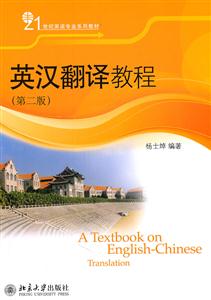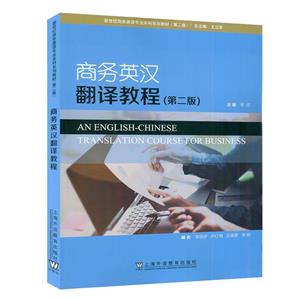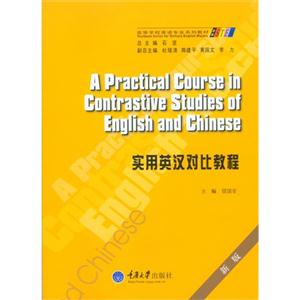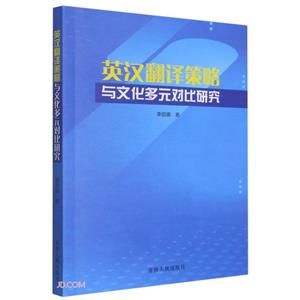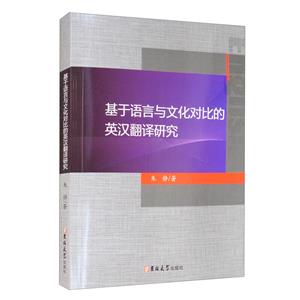
作者:贾钰
页数:194
出版社:北京语言大学出版社
出版日期:2018
ISBN:9787561953594
电子书格式:pdf/epub/txt
内容简介
《英汉翻译对比教程》专为学习汉语的外国人编写,适用于来自英语国家地区以及熟练掌握英语的学习者。本书以翻译练习为手段进行英汉的语言对比,通过英译汉的方式,从对比的角度,揭示汉语的一些特点,培养学生关注语言形式的学习习惯,提高抗语际干扰的意识和能力,从而提高语言学习能力。可作为汉语专业的二年级教材使用,也可供课外自学。
作者简介
贾钰,北京语言大学汉语国际教育学部进修学院副教授,从事对外汉语教学工作至今二十八年。曾受邀任教于韩国湖西大学和英国兰开夏中央大学。主要研究兴趣在对外汉语教学法、对外汉语教学语法、汉英语言对比分析方面。主要论文包括:《现代汉语的“着”与英语的“进行体”》《汉语“被”字句与英语“被动式”的功能对比》《汉英句子中“相继行为”的连接手段》《外国人情态补语句偏误分析》《英国大学本科学历的汉语教学》《近二十年对外汉语教学领域汉英语法对比研究综述》《“来/去”作趋向补语时动词宾语的位置》等。
本书特色
l Learn translation through the use of authentic materials
选取地道语料,供学生翻译、学习
l Detailed notes on difficult Chinese grammar points
详细讲解汉语语法难点
l Numerous sample exercises with answers
提供海量例题,后附参考答案
l Learn through self-discovery
提倡发现式学习
目录
Chapter 1 Choosing the Correct Words According to Context 根据语境选择译词Chapter 2 Translation of Prepositional Phrases Denoting Spatial Relationships Chinesegrammarpoints:prepositions在,于,沿,从;directionalverbs suchas来/去as complements; 到/在/进as complement ofresult;把一sentence with a complement ofresult 表示空间关系的介词短语做状语的汉译 汉语语法点:介词“在”“于”“沿”“从”;趋向动词“来/去”等做补语;“到”“在”“进”做结果 补语;带结果补语的“把”字句Chapter 3 Translation of Prepositional Phrases Denoting Time Chinese grammar points:adverbials denoting points of time;their position and order in a sentence; complemems denoting a time span;their position in a sentence 表示时间的介词短语做状语的汉译 汉语语法点:表示时点的状语在句中的位置和顺序;表示时量的补语在句中的位置Chapter 4 Translation of Prepositional Phrases Denoting Cause,Purpose or Result Chinese grammar points:conjunctions因为,由于;prepositions出于,为/为了and conjunction以便; complemem of state marked by得,成—a complement of result;double-verb construction;R-sentence with【V+成】 表示原因、目的、结果的介词短语做状语的汉译 汉语语法点:连词“因为”“由于”;介词“出于”“为/为了”与连词“以便”;“得”字情态补语; 结果补语“成”;连动式;带【V+成】的“把”字句Chapter 5 Translation of Prepositional Phrases Denoting Means or Instrument Chinesegrammarpoints:words expressingmeansorinstrumentinChinese用,通过,靠,凭,根据,从 表示工具、方法、途径的介词短语做状语的汉译 汉语语法点:表示工具、方法、途径的词语——“用”“通过”“靠”“凭”“根据”“从”Chapter 6 Translation of Prepositional Phrases Denoting Manner Chinese grammar points:adverbials of manner;complement of state 表示方式或状态的介词短语做状语的汉译 汉语语法点:表示方式或状态的状语;情态补语Chapter 7 Translation of Sentences with Postmodification of Nouns Chinese grammar points:position ofnoun modifiers;clausal sentences;sentences with有:word order 带名词后置定语的句子的汉译 汉语语法点:定语的位置;分句;带“有”的句子;语序Chapter 8 Translation of Noun Phrases with Multiple Modification Chinese grammar points:sub—division of noun modifcation and order of multiple noun modifiers: word order 带多项定语的名词短语的汉译 汉语语法点:定语的分类和多项定语的顺序;语序Chapter 9 Translation of Passive Voice without an Expressed Agent Chinese grammar points:pseudo-actives(notional passives);是……的construction for emphasis; 被-sentence;other lexical means to express passive sense:得到,受到,遭到 不带施事的被动式的汉译 汉语语法点:受事主语句(意义被动句);起强调作用的“是……的”结构;“被”字句;其他 表示被动意义的词汇手段——“得到”“受到”“遭到”Chapter 10 Translation of Passive Voice with an Expressed Agent Chinese grammar points:active forms including把sentence;是or是……的construction for emphasis: 被一sentence;other lexical means to express passive sense:得到,受到,遭到 带施事的被动式的汉译 汉语语法点:包括“把”字句的主动句;起强调作用的“是”字句或“是……的”结构;“被” 字句;其他表示被动意义的词汇手段——“得到”“受到”“遭到”Chapter 11 Conversion of Word Class in Translation Chinese grammar points:the typological feature ofthe Chinese language;the use ofverbs 英译汉中的词类转换 汉语语法点:汉语的类型特征;动词的使用Chapter 12 Translation of Long English Sentences Chinese grammar points:features and logic order of Chinese sentences 英语长句的汉译 汉语语法点:汉语句子的特点和逻辑顺序Sampte Answers to Exercises练习参考译文Gtossarg专业术语







